Related Research Articles

Sir William Matthew Flinders Petrie, FRS, FBA, commonly known as Flinders Petrie, was an English Egyptologist and a pioneer of systematic methodology in archaeology and preservation of artefacts. He held the first chair of Egyptology in the United Kingdom, and excavated many of the most important archaeological sites in Egypt in conjunction with his wife, Hilda Petrie. Some consider his most famous discovery to be that of the Merneptah Stele, an opinion with which Petrie himself concurred.
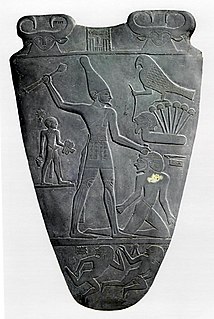
Narmer was an ancient Egyptian pharaoh of the Early Dynastic Period. He was the successor to the Protodynastic king Ka. Many scholars consider him the unifier of Egypt and founder of the First Dynasty, and in turn the first king of a unified Egypt. A majority of Egyptologists believe that Narmer was the same person as Menes.
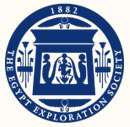
The Egypt Exploration Society (EES) is a British non-profit organization. The society was founded in 1882 by Amelia Edwards and Reginald Stuart Poole in order to examine and excavate in the areas of Egypt and Sudan. The intent was to study and analyze the results of the excavations and publish the information for the scholarly world. The EES have worked at many major Egyptian excavation and sites. Their discoveries include the discovery of a shrine for the goddess Hathor, a statue of a cow from Deir el-Bahri, the mortuary temple of Queen Hatshepsut, and the sculpted model of Nefertiti from Amarna. The Society has made major contributions to the study of the ancient Egyptian world. The Society is based in London and is a registered charity under English law.

The Petrie Museum of Egyptian Archaeology in London is part of University College London Museums and Collections. The museum contains over 80,000 objects and ranks among some of the world's leading collections of Egyptian and Sudanese material.
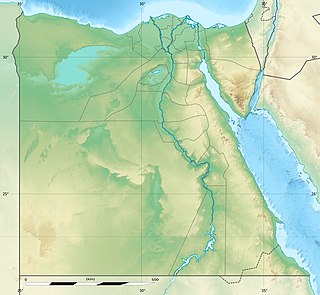
Hu is the modern name of an Egyptian town on the Nile, which in more ancient times was the capital of the 7th Nome of Upper Egypt.

Iry-Hor or Ro was a predynastic pharaoh of Upper Egypt during the 32nd century BC. Iry-Hor's existence was debated, with the Egyptologist Toby Wilkinson contesting the reading and signification of his name. However, continuing excavations at Abydos in the 1980s and 1990s and the discovery in 2012 of an inscription of Iry-Hor in the Sinai confirmed his existence. Iry-Hor is the earliest ruler of Egypt known by name and is sometimes cited as the earliest-living historical person known by name.
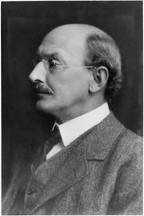
Francis Llewellyn Griffith was an eminent British Egyptologist of the late 19th and early 20th centuries.

John Garstang was a British archaeologist of the Ancient Near East, especially Anatolia and the southern Levant. He was the younger brother of Professor Walter Garstang, FRS, a marine biologist and zoologist. Garstang is considered a pioneer in the development of scientific practices in archaeology as he kept detailed records of his excavations with extensive photographic records, which was a comparatively rare practice in early 20th-century archaeology.

Edward Russell Ayrton was an English Egyptologist and archaeologist.

Barbara Georgina Adams, FRSA was a distinguished British Egyptologist and specialist in predynastic history. She worked for many years at Hierakonpolis, where she was the co-director of the expedition. Before this she worked at the Petrie Museum of Egyptian Archaeology in London and worked on excavations across Britain.
Sequence dating, a relative dating method, allows assemblages to be arranged in a rough serial order, which is then taken to indicate time. Sequence dating is a method of seriation developed by the Egyptologist Sir William Matthew Flinders Petrie. By linking styles of pottery with different time periods, he was able to establish the relative chronology of the site.
Sewadjenre Nebiryraw was an ancient Egyptian pharaoh of the Theban-based 16th Dynasty, during the Second Intermediate Period.

The Naqada culture is an archaeological culture of Chalcolithic Predynastic Egypt, named for the town of Naqada, Qena Governorate. A 2013 Oxford University radio carbon dating study of the Predynastic period, however, suggests a much later date beginning sometime between 3,800–3,700 BC.
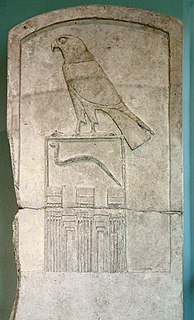
Émile Amélineau was a French Coptologist, archaeologist and Egyptologist. His scholarly reputation was established as an editor of previously unpublished Coptic texts. But his reputation was destroyed by his work as a digger at Abydos, after Flinders Petrie re-excavated the site and showed how much destruction Amélineau had wrought.
The Tasian culture is possibly the oldest-known Predynastic culture in Upper Egypt, which evolved around 4500 BC. It is named for the burials found at Deir Tasa, a site on the east bank of the Nile located between Asyut and Akhmim. The Tasian culture group is notable for producing the earliest blacktop-ware, a type of red and brown pottery, which has been painted black on its top and interior. This pottery is vital to the dating of the various predynastic Egyptian civilizations. Since all dates for the Predynastic period are tenuous at best, Flinders Petrie developed a system called Sequence Dating through which the relative date, if not the absolute date, of any given Predynastic site can be ascertained by examining the handles on pottery.

Arthur Cruttenden Mace was a Tasmanian-born English archaeologist and Egyptologist. He is best known for his work for the New York Metropolitan Museum, and as a part of Howard Carter's team during the excavation of Tutankhamun's tomb.
Repyt was an ancient Egyptian goddess. She was normally portrayed as a lioness goddess of Egypt. Her husband was Min.

Hilda Mary Isabel Petrie was an Irish-born British Egyptologist and wife of Flinders Petrie, the father of scientific archaeology. Having studied geology, she was hired by Flinders Petrie at age 25 as an artist, which led to their marriage and a working partnership that endured for their lifetimes. Hilda travelled and worked with Flinders Petrie to excavate and record numerous sites in Egypt, and later in Palestine. This included directing some excavations herself, and working in often difficult and dangerous conditions to produce copies of tomb hieroglyphs and plans, and to record the work for reports to the Egypt Exploration Fund. When the British School of Archaeology in Egypt was founded in 1905 in London by Flinders Petrie, she worked as its secretary and fundraiser to secure support for the school and their continued excavations. Hilda took part in archaeological excavations and surveys throughout her married life, except for a period while their two children were young. Her work was published, and she also gave public lectures in London and elsewhere.

Olga Tufnell was a British archaeologist who assisted on the excavation of the ancient city of Lachish in the 1930s. She had no formal training in archaeology, but had worked as a secretary for Flinders Petrie for a number of years before being given a field assignment. Olga then went on to join James Leslie Starkey in the expedition to find Lachish in 1929 and remained part of the team for the following seasons.
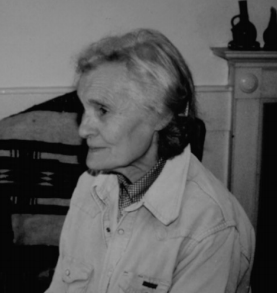
Joan Crowfoot Payne was a British archaeologist specialising in the study of lithics from the Ancient Near East and worked as Cataloguer of the Ancient Egyptian collection at the Ashmolean Museum in Oxford.
References
- ↑ from page 1 of Diospolis Parva: The Cemeteries of Abadiyeh and Hu, 1898-9 by William Matthew Flinders Petrie, Arthur Cruttenden Mace(1901) retrieved approx 17:30 30.9.11
- ↑ article HIW (PREDYNASTIC) written by Thomas Hikade-UCLA Encyclopedia of Egyptology Department of Near Eastern Languages and Cultures, UC Los Angeles(with 18 referenced sources)(12-23-2010 retrieved 21:35GMT 30.9.11)UC Los Angeles
- ↑ from page 2 of Diospolis Parva: The Cemeteries of Abadiyeh and Hu, 1898-9 by William Matthew Flinders Petrie, Arthur Cruttenden Mace(1901) retrieved approx 17:42 30.9.11
- ↑ Museum of Classical Archaeology, Memorial Tower Building , University of Natal (Durban) Archived May 18, 2007, at the Wayback Machine retrieved approx' 17;49 30.9.11